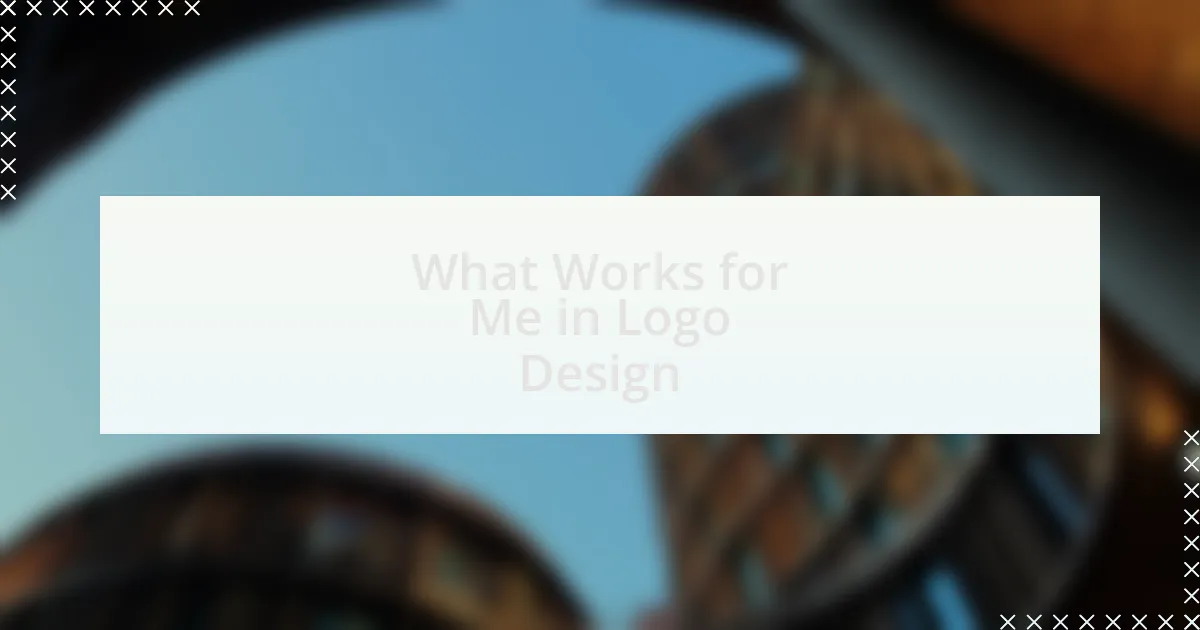Key takeaways:
- Effective logo design is rooted in principles like simplicity, versatility, and emotional resonance, which help communicate a brand’s identity.
- The logo creation process involves brainstorming concepts, sketching initial ideas, and refining designs to ensure alignment with the brand’s values.
- Personal inspiration, such as nature observations, plays a crucial role in developing design ideas and mood boards that encapsulate the brand’s essence.
- Finalizing a logo requires revisiting the brand’s narrative to ensure that every detail meaningfully reflects its purpose and values.
Author: Oliver Bancroft
Bio: Oliver Bancroft is an accomplished author and storyteller known for his vivid narratives and intricate character development. With a background in literature and creative writing, Oliver’s work often explores themes of human resilience and the complexities of modern life. His debut novel, “Whispers of the Forgotten,” received critical acclaim and was nominated for several literary awards. In addition to his fiction, Oliver contributes essays and articles to various literary magazines. When he’s not writing, he enjoys hiking and exploring the great outdoors with his dog, Max. Oliver resides in Portland, Oregon.
Understanding logo design principles
Logo design principles form the bedrock of effective branding, guiding how a logo communicates a business’s identity. I remember a project where simplicity was key; we stripped down the design to its essence. That experience taught me that a clean, uncomplicated logo can often be more memorable than a cluttered one.
Another essential principle is versatility. A logo has to work across various mediums, from business cards to billboards. I often ask myself, “Will this design hold its impact in black and white?” This question has saved me from potential pitfalls, ensuring that the logo remains strong, no matter where it appears.
The emotional resonance of a logo is often overlooked. I once designed a logo for a local bakery that had a warm, inviting color palette. It not only reflected the brand’s essence but also tugged at people’s heartstrings, forging an immediate connection. Isn’t it fascinating how a visual element can evoke such strong feelings? It reminds me that design isn’t just about aesthetics; it’s about storytelling.
Steps for creating a logo
Creating a logo begins with brainstorming concepts that resonate with the brand’s values. I remember working with a tech startup, where we mapped out keywords that defined their mission. By clustering ideas around these terms, we laid the groundwork for a logo that authentically represented their innovative spirit. Have you ever thought about how vital it is to align a logo with what the business stands for? It truly sets the stage for the entire design process.
Next, sketching out initial ideas is an integral step that lets creativity flow without restrictions. When I designed a logo for a yoga studio, I filled pages with rough sketches. Each version evolved based on instinct and feedback, highlighting elements that stood out or felt off. This exploratory phase can be messy, but isn’t that where the magic often happens? It allows us to visualize and hone in on the essence of the brand before diving into digital tools.
Finally, refining the chosen design is crucial to ensure that it meets the principles of effective logo design. I recall a time I spent hours adjusting colors and fonts for an outdoor adventure brand. It was captivating to see how a slight tweak could transform the overall vibe of the logo. How does that feel when you finally nail the details? It’s a rewarding part of the journey that reinforces the importance of being meticulous in the latter stages of logo creation.
My personal logo design process
When I start my logo design process, I often find inspiration from the simplest observations around me. For instance, while hiking one afternoon, I noticed how the contours of the hills reflected the nuances of nature’s palette. This experience sparked an idea for a logo I later created for an eco-friendly brand. It taught me that inspiration can come from anywhere if you stay aware and open.
After gathering my thoughts, I usually develop a mood board that encapsulates the vibe I want to convey. I vividly remember piecing together colors, textures, and typography that represent the essence of a small bakery I collaborated with. It was exhilarating to see how the visual elements created an emotional connection, capturing the warmth and creativity of their delicious artisan breads. Have you ever felt that rush when an idea starts to take shape visually? It’s one of those moments that keeps me passionate about design.
As I approach the finalization of a logo, I often revisit the brand’s story to ensure every detail aligns. In crafting a logo for a non-profit, I spent a considerable amount of time refining the symbolism of their mission. I kept asking myself, “Does this truly reflect their purpose?” It’s essential to me that the final product not only looks appealing but also carries weight and meaning. That’s where I find fulfillment in my work, knowing my design serves a greater narrative.

Leave a Reply